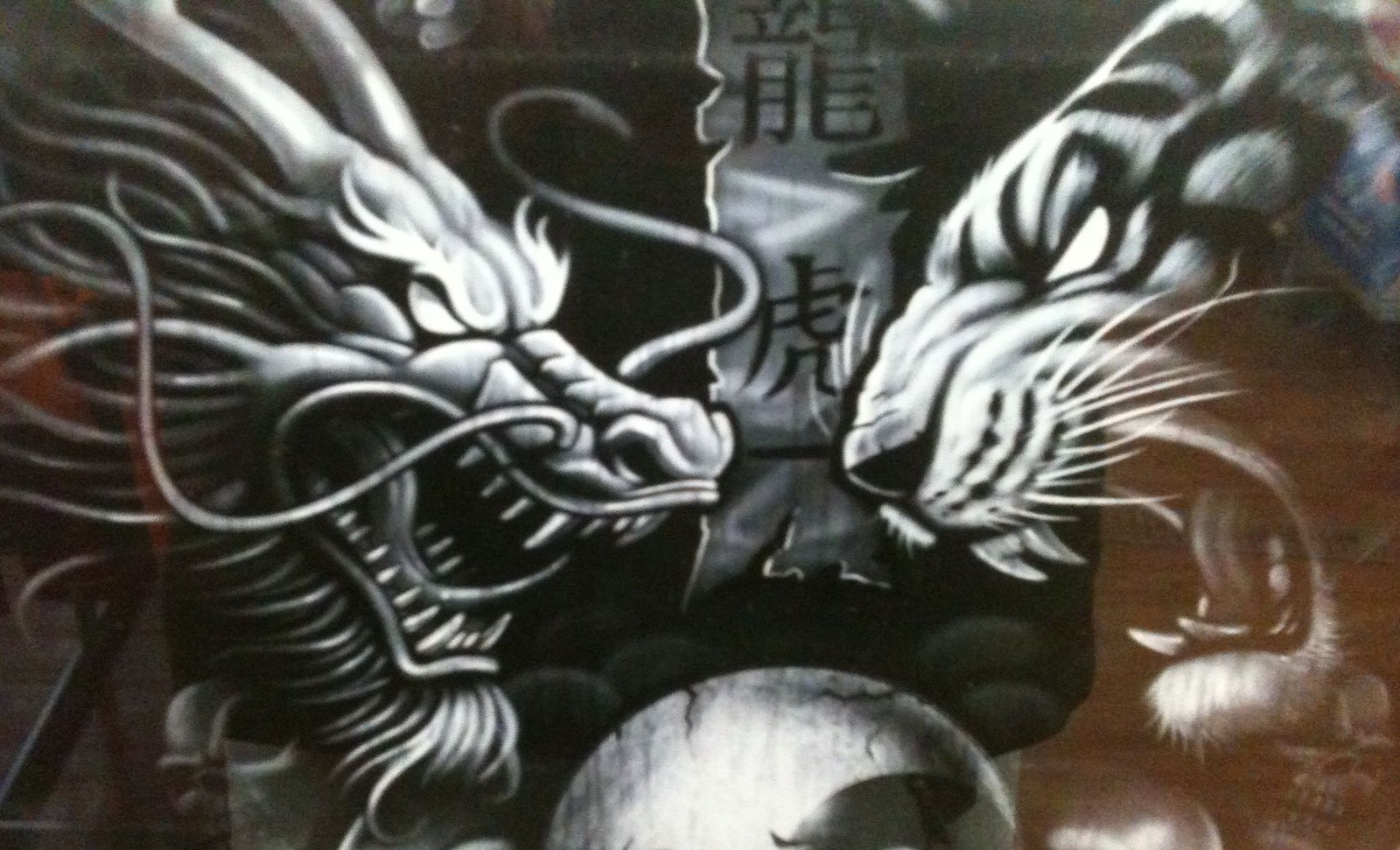
The Tiger Dragon is a powerful and enigmatic symbol that has captured the imagination of people across various cultures for centuries. While “Tiger” and “Dragon” are often used separately in mythology and folklore, their combination in the term “Tiger Dragon” carries a unique and profound meaning. This article explores the origins, cultural significance, symbolism, and modern interpretations of the Tiger Dragon , making it an informative and SEO-optimized resource for readers interested in mythology, cultural studies, and symbolic meanings.

The Origins of the Tiger Dragon
The concept of the Tiger Dragon is not rooted in a single culture but rather emerges from the rich tapestry of global mythology and folklore. In many ancient traditions, both the tiger and the dragon are revered as symbols of power, strength, and supernatural abilities. However, the fusion of these two creatures into a singular entity—the Tiger Dragon —is more commonly found in East Asian cultures, particularly in Chinese and Japanese mythology.
In traditional Chinese cosmology, the tiger and the dragon are considered two of the most important and auspicious animals. The dragon is associated with the heavens, water, and imperial power, while the tiger represents the earth, strength, and protection. When combined, the Tiger Dragon symbolizes a perfect balance between the earthly and the celestial, the physical and the spiritual. This duality makes the Tiger Dragon a powerful emblem of harmony and transformation.
In Japanese folklore, the Tiger Dragon (or tora ryū ) is sometimes depicted as a mystical creature that can transform between a tiger and a dragon. These beings are often portrayed as guardians of sacred places or as protectors of the emperor. The idea of a creature that embodies the strengths of both animals reflects the deep respect for nature and the supernatural in Japanese culture.
Cultural Significance of the Tiger Dragon
The Tiger Dragon holds immense cultural significance in several regions, especially in East Asia. In China, the tiger and the dragon are two of the four great mythical creatures, along with the phoenix and the qilin. Each of these creatures represents different aspects of life, and together they form a complete cosmic order. The tiger is often associated with bravery and protection, while the dragon is linked to wisdom and prosperity. When combined, the Tiger Dragon becomes a symbol of ultimate power and divine authority.
In Chinese astrology, the Tiger Dragon is not a specific zodiac sign, but the tiger and the dragon are both significant. The Year of the Tiger and the Year of the Dragon are highly regarded in the Chinese calendar, each bringing its own set of characteristics and energies. People born in these years are believed to possess strong willpower, courage, and leadership qualities. The Tiger Dragon can be seen as a metaphor for those who embody both these traits, representing a person who is both fierce and wise.
In Japan, the Tiger Dragon is less common than in Chinese mythology, but it still appears in certain regional legends and artistic representations. Some stories tell of a dragon that takes the form of a tiger to protect the land or to test the strength of warriors. These tales highlight the reverence for both animals and the belief in their supernatural abilities.

Symbolism of the Tiger Dragon
At its core, the Tiger Dragon is a symbol of power, strength, and transformation. The tiger, known for its ferocity and agility, represents raw energy and primal instincts. It is often associated with the night, the forest, and the wild, symbolizing freedom and independence. On the other hand, the dragon, with its majestic wings and ability to control the elements, represents wisdom, longevity, and spiritual enlightenment. Together, the Tiger Dragon embodies the perfect union of these forces.
In many mythologies, the Tiger Dragon is also a symbol of protection. It is believed that this creature can ward off evil spirits and bring good fortune to those who honor it. In some cultures, people wear charms or carry talismans shaped like a Tiger Dragon to ensure safety and prosperity. This practice is similar to the use of dragon and tiger motifs in traditional jewelry and amulets, which are thought to offer protection and strength.
Another important aspect of the Tiger Dragon is its association with change and renewal. Both the tiger and the dragon are often linked to cycles of nature, such as the changing of seasons or the rise and fall of empires. The Tiger Dragon , therefore, can represent a period of transformation, where old structures are broken down and new ones are built in their place. This makes it a powerful symbol for personal growth, leadership, and societal evolution.
The Tiger Dragon in Art and Literature
Throughout history, the Tiger Dragon has been a popular subject in art, literature, and performance. In traditional Chinese paintings, the Tiger Dragon is often depicted in dynamic poses, showing the creature in motion. These artworks emphasize the fluidity and power of the Tiger Dragon , capturing the essence of its dual nature. The colors used in these paintings are also significant, with red and gold being common choices to symbolize luck, wealth, and vitality.
In literature, the Tiger Dragon appears in various forms, from epic poems to modern fantasy novels. In classical Chinese literature, dragons are often portrayed as wise and noble beings, while tigers are depicted as fierce and independent. When combined, the Tiger Dragon becomes a character that embodies both qualities, making it a compelling figure in storytelling. For example, in the famous novel Journey to the West , although the main characters are not directly related to the Tiger Dragon , the themes of transformation and spiritual growth are similar to those associated with the Tiger Dragon .
In modern fantasy fiction, the Tiger Dragon is often used as a powerful guardian or a mystical beast that helps the protagonist on their journey. These portrayals draw inspiration from traditional myths but also adapt them to fit contemporary narratives. As a result, the Tiger Dragon continues to evolve as a symbol, remaining relevant in both ancient and modern contexts.

The Tiger Dragon in Popular Culture
In recent years, the Tiger Dragon has gained renewed popularity through movies, television shows, and video games. One of the most well-known examples is the animated film Mulan (1998), where the character Mushu, a small dragon, serves as a comedic sidekick. While not a Tiger Dragon , this portrayal highlights the enduring fascination with dragons and their connection to human stories.
In video games, the Tiger Dragon appears as a powerful boss or companion in several titles. For instance, in World of Warcraft , players may encounter dragon-like creatures that share similarities with the Tiger Dragon . These games allow players to interact with the Tiger Dragon in a virtual environment, giving them a deeper appreciation for its mythical qualities.
Television shows and web series have also explored the Tiger Dragon in various ways. Some dramas incorporate the Tiger Dragon as a central motif, using it to symbolize the struggles and triumphs of the characters. Others use it as a visual element to enhance the atmosphere of a scene, adding a sense of grandeur and mystery.
The Tiger Dragon in Feng Shui and Interior Design
In the practice of Feng Shui, the Tiger Dragon is considered a powerful symbol that can influence the energy of a space. According to Feng Shui principles, the placement of certain objects and symbols can affect the flow of chi (life force) in a home or office. The Tiger Dragon is often used in this context to promote strength, protection, and success.
When placed in a living room or office, a Tiger Dragon sculpture or painting is believed to enhance the owner’s confidence and decision-making abilities. It is also said to attract positive energy and repel negative influences. Many people choose to display the Tiger Dragon in areas where they want to strengthen their career or personal ambitions.
In addition to its symbolic value, the Tiger Dragon is also appreciated for its aesthetic appeal. Its intricate design and vibrant colors make it a popular choice for decorative items such as wall art, sculptures, and jewelry. Whether used for spiritual purposes or simply as a beautiful ornament, the Tiger Dragon adds a touch of mystique and power to any space.

The Tiger Dragon in Modern Spirituality and Personal Growth
Beyond its cultural and artistic significance, the Tiger Dragon has also become a symbol of personal empowerment and spiritual growth. Many individuals turn to the Tiger Dragon as a source of inspiration and motivation, drawing on its qualities of strength, wisdom, and resilience.
In meditation and mindfulness practices, the Tiger Dragon is sometimes used as a visualization tool. Practitioners imagine themselves as a Tiger Dragon , channeling its energy to overcome challenges and achieve their goals. This technique helps individuals connect with their inner strength and tap into their full potential.
The Tiger Dragon is also associated with the idea of transformation. Just as the tiger and the dragon represent different aspects of existence, the Tiger Dragon encourages people to embrace change and grow beyond their limitations. This makes it a valuable symbol for those undergoing personal development or seeking a deeper understanding of themselves.
The Tiger Dragon in Mythology and Folklore
In various mythological traditions, the Tiger Dragon is often depicted as a guardian of sacred places or a guide for heroes. In some stories, it is said that the Tiger Dragon protects the entrance to the underworld or the gates of heaven, ensuring that only the worthy may pass through. These tales emphasize the Tiger Dragon ’s role as a protector and a symbol of divine justice.
In other myths, the Tiger Dragon is a trickster figure, using its intelligence and cunning to outwit others. This duality reflects the complex nature of the Tiger Dragon , which can be both a benevolent guardian and a mischievous spirit depending on the story. Such tales highlight the versatility of the Tiger Dragon as a mythological figure and its ability to adapt to different narratives.
One of the most famous legends involving the Tiger Dragon comes from Chinese folklore, where it is said that the Tiger Dragon once lived in the mountains and helped a poor farmer by granting him a wish. In return, the farmer was expected to honor the Tiger Dragon with offerings and prayers. This story illustrates the mutual relationship between humans and mythical creatures, emphasizing the importance of respect and gratitude.
The Tiger Dragon in Modern Media and Entertainment
In today’s digital age, the Tiger Dragon has found new life in various forms of media. From animated series to comic books, the Tiger Dragon continues to inspire creators and audiences alike. One notable example is the Avatar: The Last Airbender franchise, where the dragon spirit Zuko is often compared to the Tiger Dragon due to his fiery personality and transformative journey.
In the world of anime, the Tiger Dragon appears in several series, often as a powerful ally or a formidable enemy. These portrayals help keep the Tiger Dragon relevant in contemporary pop culture, allowing new generations to discover and appreciate its symbolism.
Video games, too, have embraced the Tiger Dragon as a powerful creature. In games like Final Fantasy and The Elder Scrolls , players can encounter Tiger Dragons or similar entities that embody the traits of both the tiger and the dragon. These experiences allow gamers to engage with the Tiger Dragon in an interactive way, deepening their understanding of its significance.

The Tiger Dragon in Spiritual Practices
In some spiritual traditions, the Tiger Dragon is seen as a manifestation of higher consciousness or a bridge between the physical and spiritual realms. Practitioners believe that meditating on the Tiger Dragon can help align one’s energy with the universe, promoting balance and harmony.
In shamanic practices, the Tiger Dragon is sometimes referred to as a spirit animal, guiding individuals through difficult times and offering protection. Those who resonate with the Tiger Dragon are often described as natural leaders, capable of navigating challenges with courage and insight.
The Tiger Dragon is also associated with the concept of the “inner warrior,” representing the part of a person that is brave, determined, and unyielding. By connecting with the Tiger Dragon , individuals can tap into this inner strength and overcome obstacles in their lives.
Conclusion
The Tiger Dragon is more than just a mythical creature—it is a powerful symbol that has influenced cultures, art, and spirituality for centuries. From its origins in East Asian mythology to its modern-day presence in entertainment and personal growth, the Tiger Dragon continues to captivate and inspire. Whether as a guardian, a guide, or a representation of inner strength, the Tiger Dragon remains a timeless and meaningful figure.
By exploring the history, symbolism, and cultural significance of the Tiger Dragon , we gain a deeper appreciation for its role in human imagination and tradition. As we continue to evolve and seek meaning in our lives, the Tiger Dragon stands as a reminder of the power of transformation, strength, and balance.



